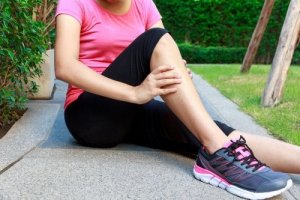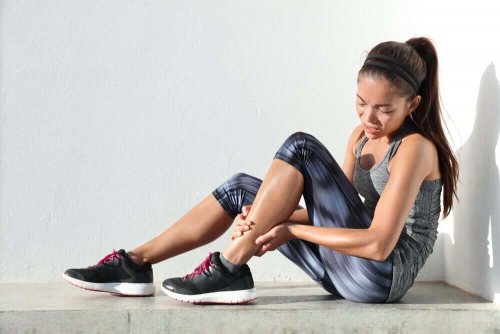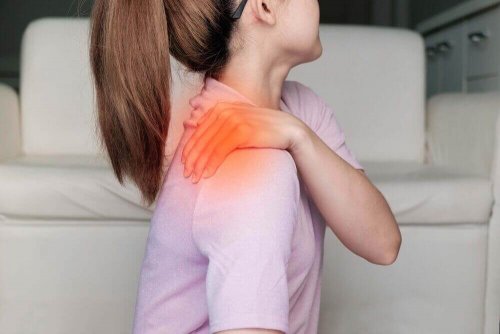Delayed Onset Muscle Soreness (DOMS)


Written and verified by the physiotherapist Michelle Torres
While delayed onset muscle soreness (DOMS) often appears after exercise, it shouldn’t be your reason to avoid strength training. Today we’ll explain what it is, why it hurts, and how to prevent it.
What’s delayed onset muscle soreness?
Delayed onset muscle soreness is the same as post-exercise muscle ache. We also know it as:
- Myalgia
- Muscle soreness
- Muscle fever
This type of pain can appear 24 or 48 hours after an intense exercise session or after doing exercises you’ve not familiar with. This pain usually takes place in the worked muscles and may lead to a decrease in strength and short term range of movement.
What you should know about delayed onset muscle soreness
DOMS is basically post-exercise muscular pain. It can manifest 24 or 48 hours after physical activity.

Also, DOMS may appear after exercising or any other type of physical activity out of the usual intensity range, such as:
- A sedentary person‘s first day in the gym
- A very intense workout
- Lifting heavy things
Muscle soreness and inflammation
People used to believe that this type of pain was due to an inflammation resulting from the breakdown of muscle fibers after exercise. However, we now know this isn’t so because:
- There may be a pain without inflammation, according to this study published in The Journal of Physiological Sciences.
- There might also be painless inflammation, according to another study from 2016 in the Frontiers in Physiology journal.
Thus, it seems that inflammation isn’t directly related to the pain of DOMS. The current hypothesis is that this type of inflammation is a reaction of the immune system to unknown stimuli (a new move or an increase in exercise intensity). However, we’ll have to wait for researchers to find out more about this topic to be able to reach better conclusions.
Is muscle soreness due to lactic acid?
No. Lactic acid doesn’t cause deferred myalgia. This was verified in a study published in 1983, where the concentration of lactic acid in the blood in two types of runners was evaluated:
- Some participants who ran 45 minutes on a treadmill without a slope had a significant increase in lactic acid, but no DOMS.
- Other people who ran the same amount of time but on a treadmill slope of minus 10% to simulate a downhill didn’t have an increase in lactic acid but had significant stiffnesses.
This little experiment showed that there’s no relationship between lactic acid and DOMS.
So why does it hurt?
Well, we don’t know for sure. One of the problems in defining the cause is that, sometimes, DOMS can even spread to muscles you don’t exercise.

However, what’s clear is that:
- Eccentric movements have a greater tendency to cause stiffness than concentric movements
- Genetics probably plays an important role as there are things that vary from person to person, such as pain sensitivity.
- The sores may get worse due to factors such as dehydration, poor diet, lack of sleep, a harsh massage, or fear of pain.
Don’t miss: 11 Exercises to Help Get Rid of Shoulder Pain
Prevention
You can’t prevent DOMS, but you can reduce the possibility of pain. Also, if it appears, it’ll be much more manageable if you do the following:
- Take it easy. Gradually increase the intensity of your exercise. This is because you won’t reach your goal faster when you force your body. It’s quite the opposite, in fact.
- The general recommendation is that you shouldn’t increase repetitions, sets, and weight over 10% per week.
- Warm-up properly. If you’ve previously had good results, then stretch after you exercise.
- Focus on adopting good habits such as taking care of your diet, sleeping well and drinking enough water.
In short, contrary to what many people think, DOMS isn’t caused by lactic acid or inflammation. While scientists are still trying to determine the exact cause, it’s a normal response of the body after exercising too intensely or doing any other physical activity outside your usual intensity range.
All cited sources were thoroughly reviewed by our team to ensure their quality, reliability, currency, and validity. The bibliography of this article was considered reliable and of academic or scientific accuracy.
- Hotfiel, T., Freiwald, J., Hoppe, M., Lutter, C. and Forst, R. (2018). Advances in Delayed-Onset Muscle Soreness (DOMS): Part I: Pathogenesis and Diagnostics. Sportverletzung Sportschaden, 32(04), pp.243-250. https://www.ncbi.nlm.nih.gov/pubmed/30537791 (accessed 16 October 2019).
- Heiss, R., Lutter, C., Freiwald, J., Hoppe, M., Grim, C., Poettgen, K., Forst, R., Bloch, W., Hüttel, M. and Hotfiel, T. (2019). Advances in Delayed-Onset Muscle Soreness (DOMS) – Part II: Treatment and Prevention. Sportverletzung Sportschaden, 33(01), pp.21-29. https://www.ncbi.nlm.nih.gov/pubmed/30865998 (accessed 16 October 2019).
- Physiopedia contributors. Delayed onset muscle soreness (DOMS). Physiopedia, date of last revision: 1 March 2019. https://www.physio-pedia.com/index.php?title=Delayed_onset_muscle_soreness_(DOMS)&oldid=206655 (accessed 16 October 2019).
- Miller, J. Wong, A. DOMS – Delayed Onset Muscle Soreness. Physioworks. Last updated 11-Oct-2019. https://physioworks.com.au/injuries-conditions-1/doms-delayed-onset-muscle-soreness (accessed 16 October 2019).
- Ingraham, P. Post-Exercise, Delayed Onset Muscle Soreness. Pain Science. Updated Apr 24, 2019. https://www.painscience.com/articles/delayed-onset-muscle-soreness.php (accessed 16 October 2019).
This text is provided for informational purposes only and does not replace consultation with a professional. If in doubt, consult your specialist.








